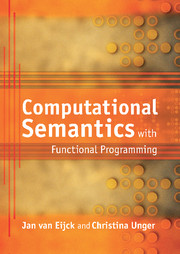Book contents
- Frontmatter
- Contents
- Foreword
- Preface
- 1 Formal Study of Natural Language
- 2 Lambda Calculus, Types, and Functional Programming
- 3 Functional Programming with Haskell
- 4 Formal Syntax for Fragments
- 5 Formal Semantics for Fragments
- 6 Model Checking with Predicate Logic
- 7 The Composition of Meaning in Natural Language
- 8 Extension and Intension
- 9 Parsing
- 10 Handling Relations and Scoping
- 11 Continuation Passing Style Semantics
- 12 Discourse Representation and Context
- 13 Communication as Informative Action
- Afterword
- Bibliography
- Index
7 - The Composition of Meaning in Natural Language
Published online by Cambridge University Press: 05 June 2012
- Frontmatter
- Contents
- Foreword
- Preface
- 1 Formal Study of Natural Language
- 2 Lambda Calculus, Types, and Functional Programming
- 3 Functional Programming with Haskell
- 4 Formal Syntax for Fragments
- 5 Formal Semantics for Fragments
- 6 Model Checking with Predicate Logic
- 7 The Composition of Meaning in Natural Language
- 8 Extension and Intension
- 9 Parsing
- 10 Handling Relations and Scoping
- 11 Continuation Passing Style Semantics
- 12 Discourse Representation and Context
- 13 Communication as Informative Action
- Afterword
- Bibliography
- Index
Summary
Summary
In the last chapter we gave an indirect interpretation for our natural language fragment. We translated natural language sentences into logical forms and then evaluated these logical forms with respect to a model. Logical forms were predicate logical formulas, which were constructed from type logical expressions. We used Haskell as a lambda calculus engine for this construction procedure. This worked very well, but it has the disadvantage that the Haskell interpreter hides the details of how expressions of typed logic get simplified. In this chapter, we will demonstrate that the composition of meaning can be carried out without a logical form language as intermediate representation level. We will give direct instructions for connecting natural language expressions to the “world” outside language (represented by an appropriate model). We will show how models of predicate logic can be extended to models of typed logic, and how typed logic yields appropriate meaning representations for the lexical items of natural language fragments and provides the means for building up meanings in a compositional way. But before we engage in this, we must focus on a key ingredient in natural language semantics: quantifiers.
Rules of the Game
An invitation to translate English sentences from an example fragment of natural language given by some set of grammar rules into some logic – predicate logic, or typed logic – presupposes two things: (i) that you grasp the meanings of the formulas of the representation language, and (ii) that you understand the meanings of the English sentences.
- Type
- Chapter
- Information
- Computational Semantics with Functional Programming , pp. 149 - 182Publisher: Cambridge University PressPrint publication year: 2010

